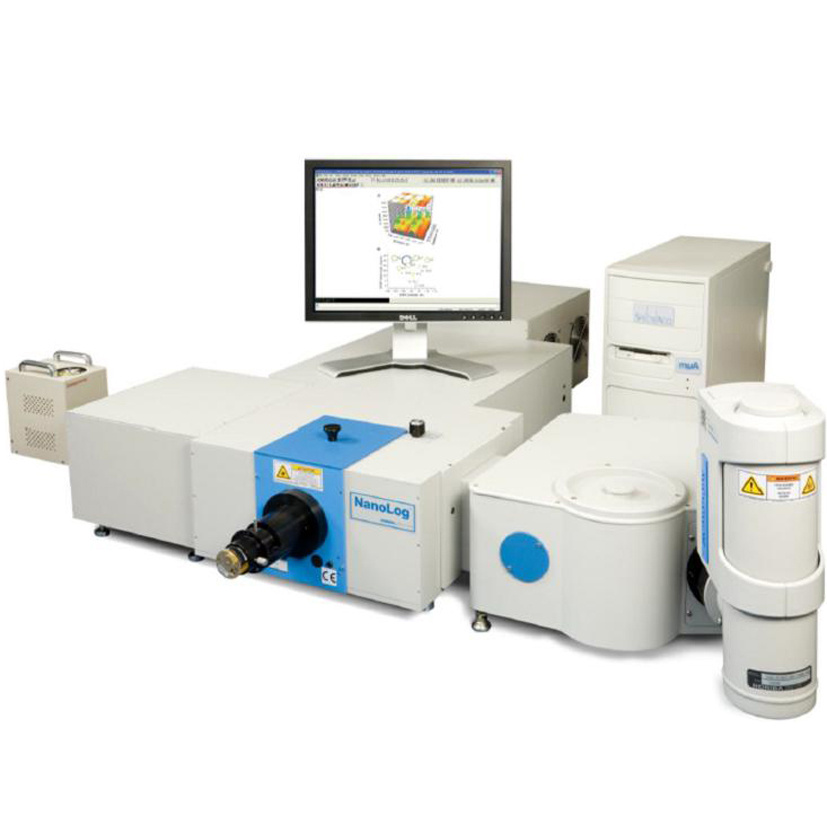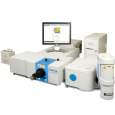方案详情
文
Photoluminescence between SWNTs is explained by invoking transfer of excitons via FRET between SWNTs within bundles. The HORIBA Jobin Yvon NanoLog® modular near-IR spectrofluorometer proved indispensable in analyzing such single-wall carbon nanotube samples.
方案详情

Introduction Most research into single-walledcarbon nanotubes (SWNTs) has beenfocused on individual tubes, rather thanbundles. Dr. P.H. Tan, A.C. Ferrari, andcolleagues atCambridge University,however, have been investigating theelectronic properties of SWNT bundlesusing photoluminescence (PL) spec-troscopy. Excitons dominate the elec-tronic structure of SWNTs, so the ex-amination of excitons not only in singletubes, but also in bundles of SWNTs, isimportant. Using PL maps of SWNTbundles might lead to better characteri-zation of samples of SWNTs. Experimental method Cobalt-molybdenum (CoMoCAT)catalytic method SWNTsS were SUS-pended in D2O with a surfactant of so-dium dodecylbenzene sulfonate(SDBS).2 To record the PL, a HORIBA.QJobin Yvon NanoLog@ modular spectro-fluorometer (Fig. 1) specializing in near-IR fluorescence was used. Results and discussion A PL map of the CoMoCAT sam-ple is shown in Fig.2. The left side (a)was recorded shortly after preparation;the right side (b) was scanned twomonths later. Assigned peaks for Fig. 2(a)) using our exclusive NanosizerTMsoftware are shown in Fig. 3. P. H. Tan, et al., “Photoluminescence Spec-troscopy of Carbon Nanotube Bundles: Evi-dence for Exciton Energy Transfer", Phys. Rev.Lett. 99(2007), 137402. 2M. J. O'Connell, et al., “Band Gap Fluores-cence from Individual Single-Walled CarbonNanotubes”, Science 297(2002), 593. Fig. 1. NanoLogmodular spectrofluorometer. Fig. 2. PL map for (a) as-prepared suspensionsand (b) after two months. Solid lines at upper leftcorners are resonances with identical excitationand recombination energies. Broken lines arethe range of phonon sidebands. Emission from(8,4), (7,6), and (9,4) SWNTs is circled, with ex-citation matching eh11, eh22, eh33 of (6,5). Ferrari and his coworkers foundsixteen different SWNT species in theCoMoCAT sample, their chirality markedwith the standard notation (m,n) in Fig. Fig. 3. Assigned peaks of as-prepared SWNTs(Fig. 2[a]). Solid circles, diamonds, and trianglesare eh11 emissions, with excitation matching theeh11, eh22, eh33, eh44 transitions. Each peak islabelled with its SWNT chiral index. Open circlesand diamonds are EET between semiconductingtubes. Gray contoursinclude bothexciton-related resonances and EET spectral features. 3. Certain intense peaks indicated exci-tons (symbolized as ehi, where i is thejh electronic interband transition E, i=1, 2, 3, 4,...). The eh; wavelengths ofmost SWNTs were redshifted 3-10 nmlonger than expected, indicating thepresence of SWTNs bundles. Other un-usual features compared with previousstudies were: Exciton resonances’ shapesWereelongated horizontally and vertically; ● New peaks appeared, including (Aexc=645 nm, Aem = 1265 nm) and (568nm, 1250 nm), with intensity muchgreater than the (eh22, eh11) peaks of(10,5), (8,7),and (9,5) SWNTs; ●A strong, broad emission near (980nm, 1118 nm) was seen. ( °M.S. Dresselhaus and P .C. Eklund, Adv. Phys.49(6),2000,705-814. ) The luminescence of the sample/as examined after two months (Fig.1[b]). Most peaks were red-shifted sev-eralnm, indicating grouping of theSWNTs into larger bundles. Thoughmost intensities fell, certain peaks grewin strength: The (980 nm, 1118 nm)band strengthened; two peaks near (568nm, 1118 nm) and (346 nm, 1118 nm)became more obvious, because of theweakness of the (ehii, eh11)(i=2, 3, 4)bands of (8,4) and (7,6) SWNTs, whichoverpowered them in the newly-madesample. These peaks do not correspondto)Kknownexcitonresonances. TheCambridge team assigned them to en-ergy-transfer between nanotubes inbundles, rather than between individualnanotubes. The efficiency of exciton-excitontransfer IA/lp (A is acceptor, D is donor)was estimated to be where TnrD,TrD, TnrA, and Tra are the radia-tive (r) and nonradiative (nr) lifetimes.For nanotube diameters 0.75-0.95 nm,the eh11 radiative lifetime is ~20-30 psatroom temperature,significantlyshorter than the theoretical radiative life-time (~10 ns). Therefore observed life-times are based on nonradiative recom-binations.Thus the equation may besimplified to In bundles, the researchers founda large efficiency lA/lp. Under eh11 ex-citation of the (5,4) SWNTs, the ratio ofphotoluminescenceintensity of all ac- ceptor tubes with emission above 900nm [such as (6,5), (7,5),(8,4), (7,6)] tothat at~831 nm of the (5,4) donors is ≥75. That is, most donors transferred en-ergy to the acceptors. In low-dimen-sional systems including SWNTs, themost efficient mechanisms of energy-transfer are (1) exciton tunnelling, (2)photon-exchange, and (3) Forster reso-nance energy-transfer (FRET). Tan, etal., attributed EET in SWNT bundles toFRET, by ruling out the other mecha-nisms as follows: Exciton-tunnelling requires that theexciton wavefunctions are coupledtogether,with the tunnelling ratesensitive to the eh11 difference in en-ergy. For the sixteen different nano-tube species present in the CoMo-CAT sample, diameters varied from0.65-1.055 nm, eh11varied from0.06-0.5 eV, and chiral angle varia-tion was from 5-26°.Exciton cou-pling ought to be strongly dependenton the particular donors and accep-tors. Yet a scan of PL emission ex-cited at the eh11 of (5,4) was quitesimilar to the absorption profile be-yond 850 nm, with no preference foryoa particular (n,m). Hence exciton-tunnelling is not the major mecha-nism, and shape or size is not impor-tant. Rather, concentration iss thecrucial factor. ●Photon-exchange is a specific formof exciton-photon coupling. This en-ergy-transfer pathway has a smallerdependence on the distance be-tween the donor and acceptor (RDA)than FRET. Thus, photon-exchangecan prove important at larger dis-tances. But the lack of major EETpeaks in isolated tube solutions.when considered with the low quan- tum-efficiency, suggests that it is notdominant between adjacent tubes ina given bundle. FRET isa quite)EefficientlEETmechanism due to resonant, near-field, dipole-dipole interactions. Bio-logical systems, conjugated poly-mers, wires, and quantum dots, allexhibit FRET at short and intermedi-ate distances. The efficiency stemsfrom the spectral overlap betweendonor emission and acceptor ab-sorption, from the RDA, and the rela-tive orientation of emission and ab-sorption dipoles. The rate of energy-transfer is proportional to RA. FRETefficiency in bundles is expected tobe high. The overlap of emission andabsorption between large- and small-gap nanotubes depends on the spe-cific donor-acceptor couple. The fastrate of EET can allow excitons to betransferred sequentially from donorto acceptor, evenn when a smallemission-absorption overlap is pre-sent, along intermediate-gap tubeswithin a bundle. SWNTs in bundlesare parallel, giving a maximum di-pole-orientationfactor.andtheyhave small wall-to-wall distance. Kiowski, et al., recently reported asatellite in the photoluminescenceexcitation(PLE) spectra of nanotubesuspensions, identified as PL emis-sion from deep excitonic (DE) states.These features are redshifted by ~40 and 130 meV relative to the maineh11 PL emission peaks. These DEsatellites can be observed in isolatednanotube suspensions if they are not ( "O. Kiowski, et al., “Direct Observation of DeepExcitonic States i n the P hotoluminescence Spectra of Single-Walled Carbon Nanotubes",Phys.Rev. Lett. 99(2007),237402. ) shadowed by the intense exciton-exciton resonances of other nano-tube species. EET is a major relaxa-tion channel for exciton decay innanotube bundles, explaining the lowluminescenceyield of large-gaptubes and strong enhancement ofluminescenceyield of small-gaptubes. DE emission satellites are ex-pected to be weaker in bundles thanin isolated nanotubes. Fig. 4. PLE maps for (a) as-prepared suspen-sions in SDBS:;(b)suspensions after twomonths; and (c) as-prepared suspensions in so-dium cholate by density-gradient ultracentrifuga-tion. All PLE maps were normalized to the inten-sity of the (6,5) (eh22,eh11) resonances. Red el-lipses show the EET-induced features; the pinkellipse indicates the DE emission satellites of(6,5) tubes. 。 FFig.4 compares PLE maps of nano-tube suspensions enriched in bun-dles [Figs. 4(a) and (b)] and isolatedtubes [Fig. 4(c)]. DE satellites are much weaker than EET features.The intensity and peak position ofDE satellites for a given nanotubespecies are only determined by itsmain eh11 PL emission peak. Thepeak position of EET features is de-pendent on both donors and accep-tors. Donors determine the excitationposition and acceptors the emissionposition of EET features. Their inten-sity is dominated by the bundle do-nor and acceptorcomposition.Hence the EETfeatures; can becomparabletto—or even muchstronger than-the PL emission fromthe associated donors or acceptors.Therefore the EET features can bedistinguished from DE emission sat-ellites in the PLE maps.Because therange of exciton energy transfer islimited to a few nm, EET is not effi-cient between individual nantubes insuspensions. Thus, the EET-inducedPLE features are a direct, simple,and independent way to identify thepresence of bundles. Conclusions Photoluminescence between SWNTs isexplained by invoking transfer of exci-tons via FRET between SWNTs withinbundles. The HORIBAJobinYvonNanoLog modular near-IRspectro-fluorometerprovedindispensableirinanalyzing such single-wall carbon nano-tube samples. ( 5 H . H. Q i an, e t al.,“Exciton E nergy Transfer inPairs of Single-Walled Carbon N anotubes",Nano Lett.8(5),2008,1363-1367. ) ( USA: H ORIBA Jobin Yvon In c ., 3880 P a rk Avenue, Edison, N J 08820-3012, Toll-Free: + 1-866-jobinyvonTel: + 1-732-494-8660, F a x: + 1 - 732-549-5125, E - mail: info@jobinyvon.com, www.jobinyvon.com France: H ORIBA Jobin Yvon S.A.S., 1 6 -18, r u e du Canal, 9 1 165 Longjumeau Cdex, ) ( T el: +33 ( 0) 1 64 54 1 300, Fax:+ 3 3 (0 ) 1 6 9 09 93 19, w w w.job i nyvon.fr Japan: H ORIBA Ltd., J Y Optical Sales Dept, Hig a s h i-Kanda, Daij i Building, 1-7-8 Higashi-Kanda ) HORIBAExplore the future Photoluminescence between SWNTs is explained by invoking transfer of excitons via FRET between SWNTs within bundles. The HORIBA Jobin Yvon NanoLog® modular near-IR spectrofluorometer proved indispensable in analyzing such single-wall carbon nanotube samples.
确定
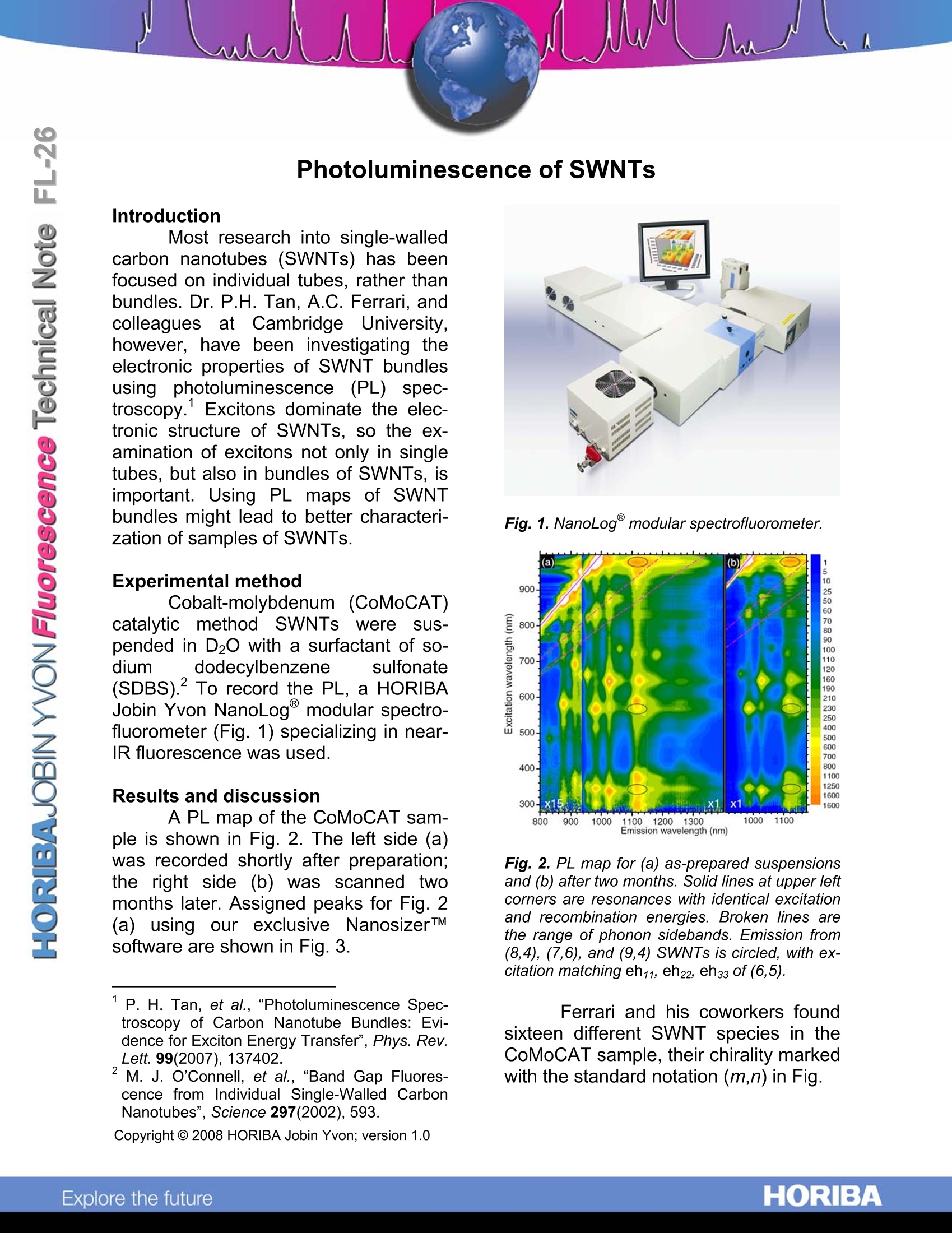
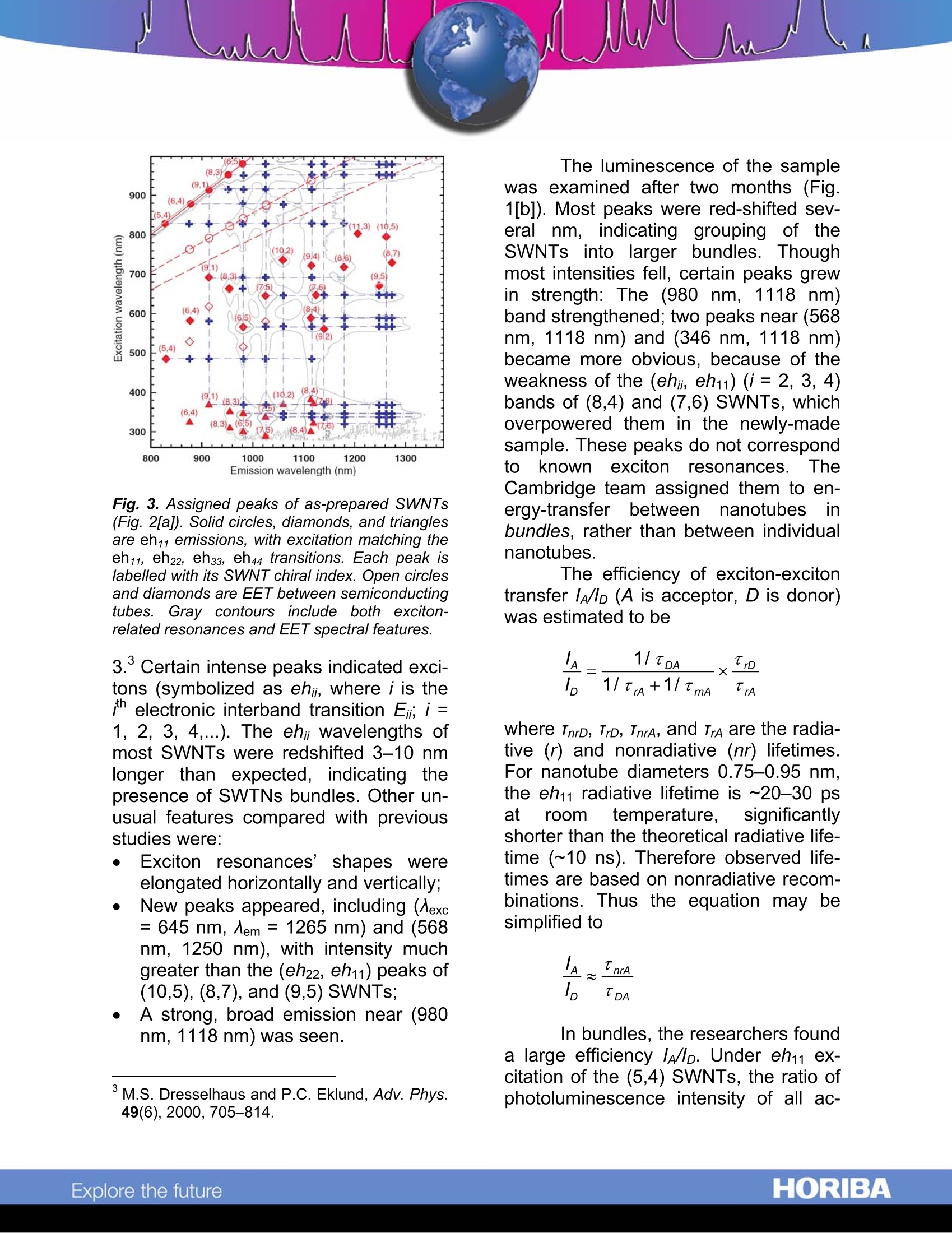
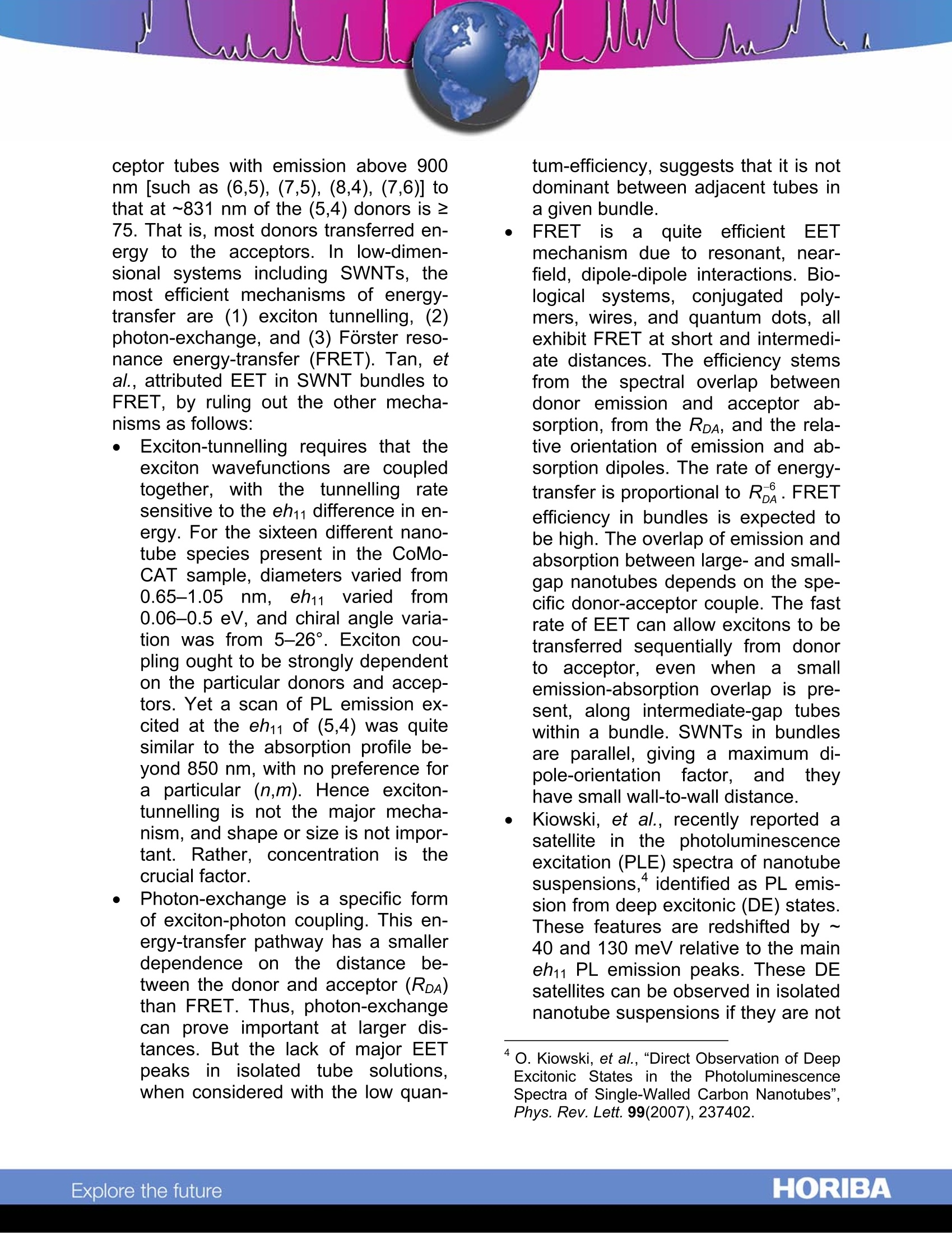

还剩2页未读,是否继续阅读?
HORIBA(中国)为您提供《单壁碳纳米管中光致发光光谱检测方案(分子荧光光谱)》,该方案主要用于纳米材料中光致发光光谱检测,参考标准--,《单壁碳纳米管中光致发光光谱检测方案(分子荧光光谱)》用到的仪器有HORIBA NanoLog®近红外荧光光谱仪
相关方案
更多
该厂商其他方案
更多

